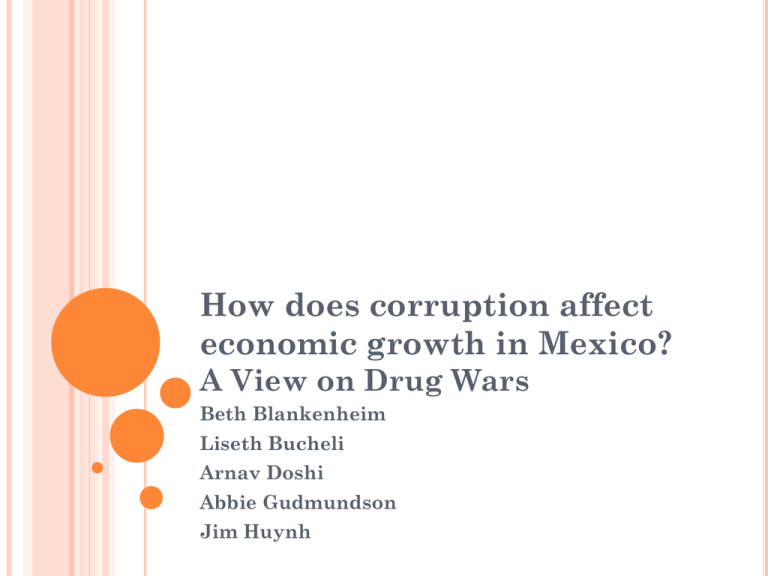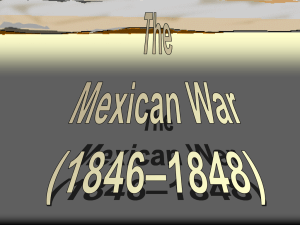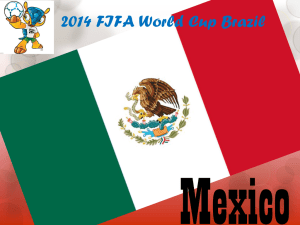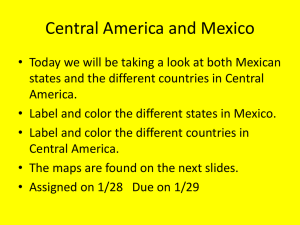group09-Mexican Drug Cartels Final
advertisement

How does corruption affect economic growth in Mexico? A View on Drug Wars Beth Blankenheim Liseth Bucheli Arnav Doshi Abbie Gudmundson Jim Huynh OUTLINE What is Corruption? How are drug cartels related to corruption? What are the economic effects of corruption? General economic effects Economic effects of cartels in Mexico How do drug cartels function? What is America’s role in the Mexican drug wars? What is being done to address this problem? Conclusions WHAT IS CORRUPTION? WHAT IS CORRUPTION? According to Carl Fredrich (1972 p.18): “Corruption is a kind of behavior which deviates from the norm actually prevalent or behaved to prevail in a given context, such as the political. It is deviant behavior associated with a particular motivation, namely that of private gain at public expense.” Corruption can be defined as “the abuse of public power for private benefit”(European Physical Journal) WHAT IS CORRUPTION? Corruption can work to enable an informal economy through various ways: Bribery Diversion of Police Resources Whenever someone in a position of power uses his or her discretion and monopoly power to accept or extort a bribe from a civilian for personal or institutional gain Bribes can be solicited or unsolicited, in return for nonenforcement of an illegal activity When officers sell or provide their legitimate police services to criminals These criminals can be primarily drug lords, prostitutes, and drug dealers (Sayed and Bruce, 1998). Kickbacks and Similar Payments Characterized as a transfer of income from one party to another by illegal arrangement WHAT IS CORRUPTION? Corruption Perceptions Index (CPI) Developed by Transparency International, a global civil organization supported by various global institutions Mexico CPI= 3.5 Source: Franko, pg. 162 HOW ARE DRUG CARTELS RELATED TO CORRUPTION? The drug war fosters corruption because it increases private gain (money) at public expense (violence) The drug war and its actors employ many forms of corruption in order to carry out illegal operations The drug war is a very serious problem and one that is unique to Latin America The economic magnitude makes this an important issue. GENERAL ECONOMIC EFFECTS OF CORRUPTION GENERAL ECONOMIC EFFECTS Corruption can affect economic growth in a number of different ways through: Foreign direct investment Tax revenues Allocation of Public services The quality of goods and services Rationality of transactions GENERAL ECONOMIC EFFECTS According to World Bank research, countries who fight corruption and improve the rule of law can increase national income as much as four times in the long run Estimate for Colombia suggests that 1% of GDP is lost to corruption Estimate for Brazil suggest that each citizen pays $6,000 annually due to corruption Average Mexican household spend 14% of income bribing government officials Correlation between higher CPI and GPA per capita: Source: European Physical Journal GENERAL ECONOMIC EFFECTS Using CPI index as a measure of Corruption, Research finds that less corrupt countries receive more foreign investments over a period from 1999-2005 (European Physical Journal) Source: European Physical Journal The findings of this study are similar to the findings of other literature GENERAL ECONOMIC EFFECTS Tax revenues is affected by corruption in two ways: Direct: Sales Tax Income Tax Import/Export tax Value Added Tax Indirect: The reduction of economic activity GENERAL ECONOMIC EFFECTS Corruption can lead to higher prices for public services: In Paraguay, the cost of roads in rural areas increased from $13 Million to $24 Million due to kickbacks Additionally, corruption can lead to irrational investments (i.e. contracts not awarded to those with best return) (Seligon) SPECIFIC ECONOMIC EFFECTS RELATED TO DRUG CARTELS IN MEXICO ECONOMIC EFFECTS OF CARTELS IN MEXICO Mexico’s GDP composition: Agriculture 4% Industry 31% Services 65% Tourism (CIA) Tourism is the third most important economic activity in Mexico, representing 8.3% of the nation’s GDP. The eighth most visited country in the world with over 20 million tourists a year. (WTTC) For 2010, Mexico is expected to generate 1,601 billion pesos ($122 billion US) ECONOMIC EFFECTS OF CARTELS IN MEXICO Profits have steadily declined as the drug cartels unleash unremitting violence against rivals and the Mexican government. Cartel tactics are becoming more violent in retaliation. There are tourist sites that are already affected extremely or slightly by the Mexican drug fiasco; other places are waiting in premonition of declines in business. The peso has devalued with respect to the US dollar so it is now cheaper to spend in Mexico. ECONOMIC EFFECTS OF CARTELS IN MEXICO ECONOMIC EFFECTS OF CARTELS IN MEXICO In Tijuana, a once-thriving city just across the border from San Diego, the increasingly deadly drug war has touched almost every part of life. In 2005, 4 million people visited Tijuana. In 2008, the number dropped to 400,000. Local residents too are fleeing in fear from the local drug cartel (Tijuana Cartel). (Worldfocus) ECONOMIC EFFECTS OF CARTELS IN MEXICO Some say that Mexico’s war on drugs is a war on its economy: The loss of the drug business is estimated to shrink Mexico’s economy by 63% in the short run. (Global Envision) Bank loans are expensive and hard to get, so traffickers have stepped in to provide small-business loans. U.S. Treasury’s blacklist of businesses (2006) suspected of drug relation: a day care, a gym, an electronics store, meatpacking plants, dairies, hotels, horse stables, gas stations, and a mining company. (USATODAY) Estimates say that cartels have laundered more than $689 million in the banks of the state of Sinaloa, and that drug money is driving nearly 20% of the state’s economy. (UNESCO) HOW DRUG CARTELS FUNCTION IN MEXICO? HOW DO DRUG CARTELS FUNCTION? Drug cartels are criminal organizations developed with the primary purpose of promoting and controlling drug trafficking operations. They range from loosely-managed agreements among various drug traffickers to formalized commercial enterprises. HOW DO DRUG CARTELS FUNCTION? Although Mexican cartels have existed for sometime, but have become increasingly powerful in recent years with the demise of the Medelin (1993) and Cali (1995) cartels in Colombia. Closure of the cocaine trafficking route through Florida also pushed cocaine traffic to Mexico, increasing the role of Mexican cartels in cocaine trafficking. HOW DO DRUG CARTELS FUNCTION? The National Drug Intelligence Center now considers Mexican drug cartels as dominating the U.S. illicit drug market. Colombian groups continue to "maintain significant control over South American cocaine and heroin smuggling and distribution in the eastern United States, although their role has diminished as that of Mexican groups has expanded. HOW DO DRUG CARTELS FUNCTION? According to the Mexican government there are seven drug cartels operating in Mexico. The Mexican government reports that the major cartels – Gulf, Sinaloa, and Juárez -- are present in much of Mexico. In recent years, the major cartels have formed alliances with one another; the two rival alliances now compete for turf. HOW DO DRUG CARTELS FUNCTION? Several cartels have also formed an alliance known as "The Federation." The Federation is led by representatives of the Sinaloa, Juárez, and Valencia cartels. The cartels work together, but remain independent organizations. The Federation tries to limit the supply hence keeping the prices high. However, the incentive to cheat is too high. HOW DO DRUG CARTELS FUNCTION? BEFORE ALLIANCES AFTER ALLIANCES HOW DO DRUG CARTELS FUNCTION? Cartel A Cartel B Collude Not Collude Collude (10 , 10) (1 , 20) Not collude (20 , 1) (5 , 5) Dominant Strategy: Cartel A “Not collude” (20 , 1) Cartel B “not Collude” (1 , 20) Nash Equilibrium: “Not Collude” (5 , 5) Pareto Efficiency dominate over Nash Equilibrium (10,10) > (5,5) HOW DO DRUG CARTELS FUNCTION? Drug war-related violence has exploded across Mexico since Felipe Calderon launched military assault against the cartels beginning in 2006. Since then, over 18,000 people connected with drug trafficking has been killed. WHAT IS AMERICA’S ROLE IN MEXICAN DRUG WARS? WHAT IS AMERICA’S ROLE IN MEXICAN DRUG WARS? Mexico is the main supplier of marijuana to the U.S. and is also a major trafficker of methamphetamine and heroin. Moreover, ~90% of cocaine entering the U.S. transits through Mexico. Mexican drug cartels now operate in almost every region of the United States and bring in as much as $23 billion a year in revenue. (Washington Post, 2007) U.S. criticism of drug trafficking and crime in Mexico is perceived by many to be unfair because most of the drugs being trafficked through Mexican territory are for consumption in the U.S. (Congressional Research Study, 2007) WHAT IS AMERICA’S ROLE IN MEXICAN DRUG WARS? “We need the U.S. to stay committed in this war in reducing demand, in stopping the flow of weapons and stopping the flow of cash.“ -- Medina Mora Mexican Attorney General U.S. law enforcement officials estimate that $12 to 15 billion a year flows from the United States to the Mexican traffickers. And that is just the bulk currency amount, actual dollar bills, and doesn't include all the money sent by wire transfers. (MSNBC, 2008) ~95% of weapons seized come the U.S. which fosters violence. WHAT IS BEING DONE TO ADDRESS THIS PROBLEM? WHAT IS BEING DONE TO ADDRESS THIS PROBLEM? S2 PRICE S1 P2 P1 D1 Q2 Q1 QUANTITY WHAT IS BEING DONE TO ADDRESS THIS PROBLEM? Calderón has employed 24,000 additional soldiers & federal police to halt illicit drug production. NGO’s call for increased penalties to deter growth in cartel membership. Obama administration has taken steps to seize drug money as well as raise shared intelligence spending by 13%. The U.S. maintains a policy of interdiction and eradication. Prohibition increases profitability. Eradication leads to negative externalities. WHAT IS BEING DONE TO ADDRESS THIS PROBLEM? PRICE S1 P1 P2 D2 Q2 Q1 D1 QUANTITY WHAT IS BEING DONE TO ADDRESS THIS PROBLEM? “As long as it is demanded, the prohibition of cocaine serves merely to make production hugely lucrative, not to halt it” (Economist, 2003) Washington Office on Latin America calls for education programs, drug prevention, and treatment. Drug prevention programs constitute 35% of US counterdrug spending although only 1/3 of school offer anti-drug curricula (2007). Decreased demand makes the drug market less lucrative. WHAT IS BEING DONE TO ADDRESS THIS PROBLEM? Government Proposals President Fox Proposal Felipe Calderón Proposal WHAT IS BEING DONE TO ADDRESS THIS PROBLEM? Mexico's federal government has introduced several measures to eliminate non-transparent practices in its public and private sectors in order to stimulate private sector growth. Anti-corruption initiatives, activities and legislation have increased significantly since 2000. WHAT IS BEING DONE TO ADDRESS THIS PROBLEM? Vicente Fox (2000 – 2006) o Felipe Calderón (2006- Present) WHAT IS BEING DONE TO ADDRESS THIS PROBLEM? Mexico's anti-corruption strategy has focused on three areas: Prisons Police force Customs President Fox pursued free market policies by introducing several liberal reforms as well as a range of measures aimed at improving the Mexican business climate. President Calderon's government has devoted much attention and resources to combating organized crime related to drug trafficking. WHAT IS BEING DONE TO ADDRESS THIS PROBLEM? 1. 2. 3. Main goals: Recognition of the role of Popular attitudes and culture in facilitating corruption. Creation of Anti-corruption initiatives targeting culture and popular attitudes. Increase the involvement of social organization on the struggle WHAT IS BEING DONE TO ADDRESS THIS PROBLEM? Felipe Calderón is focused on providing greater public safety, fighting crime, generating investment and employment to reduce poverty, and continuing to promote greater transparency in government and access to information. Key areas needing attention in countering corruption: Political funding Government records Conflict of interest Government ethics Protection of whistleblowers WHAT IS BEING DONE TO ADDRESS THIS PROBLEM? On the political agenda, the fight against narcotics is a special focus area. President Calderon's government has devoted much attention and resources to combating organized crime related to drug trafficking. WHAT IS BEING DONE TO ADDRESS THIS PROBLEM? Corruption Perception Index Mexico Year 1988-1992 1980-1985 Corruption Perceptions Index 2008 3.6 2007 2006 2005 2004 2003 2002 2001 2000 1999 1998 1997 1996 3.5 3.3 3.5 3.6 3.6 3.6 3.7 3.3 3.4 3.3 2.66 3.3 2.23 1.87 There are very low levels of trust in the public administration and in politicians CONCLUSIONS CONCLUSIONS: In addition to the negative criminal and social effects accompanying drug smuggling, the cartels' enormous economic power has fueled high levels of police corruption. The police is believed to be on cartels' payroll, especially in Northern States, where cartels smuggle drugs into the US. An increasing number of public agencies and initiatives have been dealing with anti-corruption in Mexico since a change of government in 2000 Mexico collaborates with the US to combat drug smuggling. Among other sources, Global Integrity 2007 reports of drug lords being extradited to the US for prosecution CONCLUSIONS: Mexico has a strong anti-corruption legal framework; however, enforcement of legislation is still a problem Many of the problems are fueled by inadequate control systems in local state administrations, and some Mexican states suffer from notoriously poor governance The federal structure of the Mexican political system is thus frequently cited as contributing to the inefficiency of federal anti-corruption initiatives CONCLUSIONS: The degrees and types of corruption that companies encounter in Mexico vary a lot between the federal, state and municipal level. Business surveys reveal that companies still cite corruption and inefficient government bureaucracy as major obstacles for doing business in Mexico In the short run, fighting illicit drug cartels will lead to greater short term violence QUESTIONS? REFERENCES Cook, Colleen. "Mexico's Drug Cartel." Congressional Research Service (2007): 2-19. Web. 20 Apr 2010. "2010 INCSR: Major Money Laundering Countries." U.S. Department of State. Bureau of International Narcotics and Law Enforcement Affairs, 01 Mar 2010. Web. 20 Apr 2010. Potter, Mark. "Mexican Drug War 'Alarming' U.S. Officials." MSNBC 25 Jun 2008: n. pag. Web. 20 Apr 2010. Astorga, Luis. "Drug Trafficking in Mexico: A First General Assessment." Management of Social Transformations. UNESCO, n.d. Web. 22 Apr 2010. Chepesiuk, Ron. "The Fall of the Cali Cartel." Crime Magazine 26 Oct 2006: n. pag. Web. 22 Apr 2010. REFERENCES Roig-Franzia, Manuel. "Mexican Drug Cartels Move North." Washington Post 20 Sep 2007: n. pag. Web. 20 Apr 2010. "Turning to the Gringos for Help." Economist 25 Mar 2010: n. pag. Web. 20 Apr 2010. Friedrich, J, Carl. (1966) Political Pathology. The political Quarterly. Vol.37 No 1 pp. 70-85 Quoted in Holmes Leslie, (1993) The End of Communist Power. Anti-Corruption Campaign and Legitimation Crisis, New York: Oxford University Press Astorga, Luis. "Drug Trafficking in Mexico: A First General Assessment." UNESCO (2010): n. pag. Web. 22 Apr 2010. REFERENCES Al-Sadig, A. (2009). The effects of corruption on fdi inflows. CATO Journal, 29(2), 267-294. Franko, P.(2007). The Puzzle of Latin American Economic Development. Maryland: Rowman & Littlefield Publishers. Morris, S. Corruption and Mexican Political Culture. University of South Alabama. Podobnik, B., Shao, J., Njavro, D., Ivanov, P. C., & Stanley, H. E. (2008). Influence of corruption on economic growth rate and foreign investment. European Physical Journal B -- Condensed Matter, 63(4), 547-550. Seligson, M. A. (2002). The impact of corruption on regime legitimacy: A comparative study of four latin american countries. Journal of Politics, 64(2), 408. The turmoil down south.(2003). Economist, 369(8348), 15-16. REFERENCES “CIA: The World Factbook." Web. https://www.cia.gov/library/publications/the-worldfactbook/fields/2012.html WTTC, . "Mexico Travel and Tourism." n. pag. Web. 22 Apr 2010. http://www.wttc.org/ WorldFocus, . "Tijuana tourism plunges as fear of drug cartels spreads." n. pag. Web. 22 Apr 2010. Hazard, Leah. "Mexico's war on drugs: a war on the economy?." (2008): n. pag. Web. 22 Apr 2010. http://www.globalenvision.org/2008/09/08/mexicos-wardrugs-war-economy Hawley, Chris. "Drug cartels threaten Mexican stability." USATODAY (2010): n. pag. Web. 22 Apr 2010. REFERENCES Global Advice Network. SNAPSHOT OF THE MEXICO COUNTRY PROFILE. 01 04 2010 <http://www.business-anticorruption.com/country-profiles/latin-america-thecaribbean/mexico/general-information/>. Morris, Stephen D. "Corruption and Mexican Political Culture." University of South Alabama, n.d. Valentine Anozie, Juhie Shinn, Katy Skarlatos, Julio Urzua. Reducing Incentives for Corruption in the Mexico City Police Force. La Follette School of Public Affairs University of Wisconsin–Madison. Madison: Board of Regents of the University of Wisconsin System, 2004.









